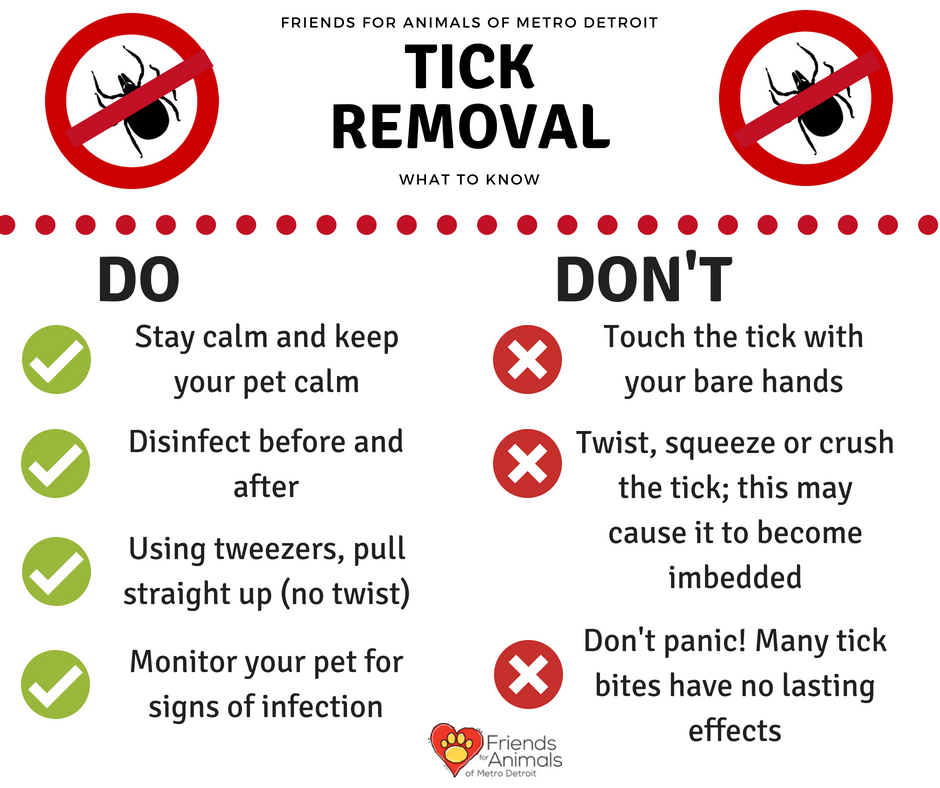
You may have heard recently about tick-borne diseases, especially Lyme Disease, becoming more common in Michigan. Here is some information for you about how you can keep your pets safe from illnesses transmitted by tick bites. [READ MORE]
Tick Transmission
Ticks tend to be most active in late spring and summer and live in tall brush or grass, where they can attach to dogs and outdoor cats. Ticks can be transferred from pets coming into the household from outdoors. They prefer to attach close to the head, neck, ears and feet, but can be found anywhere on your pet’s body. Ticks are particularly prominent in warm climates and certain wooded areas of the Northeast, but deer ticks have spread to Michigan as well.
How Do I know if My Pet Has Ticks?
Most ticks are visible to the naked eye. Ticks are often the size of a pinhead before they bite, and not noticed until they swell with blood. While these parasites rarely cause obvious discomfort, it is a good idea to check your pet regularly if you live in an area where ticks are prevalent, especially if he spends a lot of time outside. Run your hands carefully over your pet every time he comes inside, and especially check inside and around the ears, head and feet.
Lyme Disease
Lyme disease is a bacterial infection that can affect humans, dogs, cats and other mammals. Its primary carrier is the deer tick, which can attach to a dog or human and transmit the bacteria that cause the disease. Clinical signs of Lyme disease include depression, swelling of the lymph nodes, loss of appetite, fever, swollen, painful joints and kidney failure. Lyme disease is most effectively treated with antibiotics. With prompt, proper treatment, your pet’s condition should start to improve within 48 hours.
Tick Treatment and Removal
If you do find a tick on your pet, it is important to take care when removing it. Any contact with the tick’s blood can potentially transmit infection to your pet or even to you. Prompt removal is necessary, but it is important to stay calm and not rush. Follow these step-by-step tick removal instructions:
Step 1: Prepare
Put on latex or rubber gloves so you’ll never have direct contact with the tick or your pet’s bite area. Because throwing a tick in the trash or flushing it down the toilet will not kill it, you should prepare a screw-top jar containing rubbing alcohol to put a tick in after removal. This also allows you to hold it for veterinary testing. If possible, enlist a partner to help you distract and soothe your pet and hold her still during removal.
Step 2: Remove
Using a pair of tweezers, grasp the tick as close to the animal’s skin as possible. Pull straight upwards with steady, even pressure and place the tick in your jar. Do not twist or jerk the tick. This may leave the mouth-parts embedded in your pet, or cause the tick to regurgitate infective fluids. Do not squeeze or crush the body of the tick, because its fluids may contain infective organisms.
Step 3: Disinfect and Monitor
Disinfect the bite area and wash your hands with soap and water, even though you were wearing gloves. Sterilize your tweezers with alcohol or by carefully running them over a flame. Monitor the bite area over the next few weeks for any signs of localized infection, such as redness or inflammation. If infection occurs, please bring your pet—and your jarred tick—to your veterinarian for evaluation.
Tick Prevention
Many of the same products on the market that treat fleas also kill ticks and prevent against future infestation. Speak to your vet about the best product for your pet. Ensure a tick-free lawn by mowing it regularly, removing tall weeds and making it inhospitable to rodents by keeping garbage covered and inaccessible.
This information courtesy of the ASPCA. For more information, contact your veterinarian or visit www.aspca.org/pet-care/general-pet-care/fleas-and-ticks